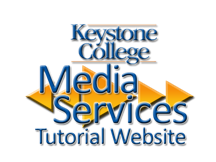Publishing/Leadership Project



I would like to present this work at the Keystone College Administrative Council meeting. This monthly gathering serves as a forum for members of the College to communicate information about current policies and explore new ideas. It also provides an avenue to voice development initiatives to the executive committee of the council, which in turn acts as a liaison to members of the Cabinet, and the President of Keystone College. I also plan to have an announcement made in several Keystone publications, including the K.C. Morning E-Notes, Keystone Chronicle, and The Keystonian. These newsletters reach a large audience of faculty, staff, students, administration, and alumni. I feel it is important that members of the Keystone community become aware of these new technology support tools. I have also submitted this work to the International Journal of Instructional Media.
Video Presentation
Providing Technology Training at Keystone College
Technology in the realm of education often isolates those distinguished faculty and learners who do not consider themselves tech savvy. This divide can prohibit teachers and students from the benefits that these tools can provide in education. There are many instructors who would like to bring these technologies to the classroom, but often become frustrated with foreign interfaces, complicated file management, and insufficient support on these systems. Such was the case at Keystone College in La Plume, Pennsylvania. Serving as the college’s part-time Course Management System(CMS) administrator, I was able to witness many of the issues that restrain technology use in the classroom and in distance education. It seemed that the divide could be closed with more easily assessable and current training on the technology. My approach to addressing this issue was to create a system that could manage training tutorials that specifically related to the instructional software and classroom technology that are being utilized at Keystone. As part of the requirements for the pursuit of a Master’s of Science degree in Educational Media Design and Technology at Full Sail University, I choose to address this as the topic of my Action Research Project.
When I began the online master’s degree program at Full Sail University, we were asked to think of a real-world problem in our workplace that we would like to address for our action research project. The focus of my project was the issue of providing proper technical support for the Blackboard CMS used at Keystone College. Administration of the CMS only makes up half of my daily duties at the school, however providing support at times enveloped my entire workday. Beyond course and user management for the system and troubleshooting software issues with the CMS, I also provide training seminars for students and faculty. These trainings are typically presented in one of the classrooms or computer labs on campus and can only reach a small audience. Also, with the recent introduction of an online business degree, we needed a system that could cover training users on the software and free up support time for other issues.
With the implementation of a course management system, there comes a need to provide proper support and training to the campus community to ensure that the tools are being utilized to their fullest extent. This involves not only training in the use of the software but also how new teaching methods are implemented through the use of the software (Bongalos, Bulaon, de Celedonio, de Guzman, & Ogarte, 2006). Without accessible support these systems often fall to the wayside at the first sign of a problem, or do not use all of the tools intrinsic to enhance the learning process. Proper support and training systems can help to alleviate some of the natural anxiety that comes with using a new or unfamiliar tool and aid in the adoption and continued use of the CMS at the institution (Ackerman, 2008). I began researching publications written on the current trends in wide scale CMS technology support and how these systems were being implemented at other organizations. The research showed that many companies and educational institutions were beginning to move to online training to familiarize their users with the technology. These resources also discussed several approaches to solving the training issue. Separate training modules would need to be developed to service the individual needs of the student, teacher, and administrator of the system. Much of the training material can be housed on the CMS system itself, however many institutions opt for training and support systems that work symbiotically with the CMS, hosted solutions for training, or use training systems delivered by the CMS provider (Olliver, Westergard, & Hesting, 2007). For the level of support required at our institution, an in-house system seemed to be the answer.
This led to the development of a website that could manage and deliver screen-capture software tutorials and video lessons on the technology that faculty and staff would be using while at Keystone. With the nature of technology and software as a continually changing entity, the system needed to dynamically change based on the new content that is made available. The turnover rate of these media tutorials is high, and they need to be kept current. However, having to continually rewrite an entire webpage to embed the new training would be management intensive and cumbersome. The site was designed using a web-programming language called PHP, or Hypertext Preprocessor, which allows the site to be easily updated. This way the site can remain current as new tutorials become available and outdated tutorials are removed. The design of this system is such that as soon as a tutorial is uploaded to our web server, it will be available to users of the system via a dynamically updated Spry menu system. The same with removing outdated tutorials, once the file is removed from the web server it will automatically be unavailable on the website. All of this happens without writing additional code. All of the video lessons are displayed in a media player called Shadowbox which plays over the top of the website, so the users don’t have to continually navigate away from the sites home page to view content. This system could serve as a backbone for a much larger training system that could eventually house and manage tutorials for all of our campus systems.
There are several different factions of users that I was attempting to address with this management system. The first and foremost is our faculty. Providing training on the use of curriculum-enhancing software’s like Blackboard may ease some of the apprehension associated with utilizing an LMS in the classroom. The next set of users that I hoped would benefit from this system was the students. From new incoming freshmen to seniors whom have not yet used our LMS, CMS, or other systems, I felt that the Keystone College Media Services training website can provide quick and easy lessons so that students could incorporate these technologies into their educational experience. The final set of users that could potentially benefit from the use of this system would have been our administration and staff. The technology systems that we utilize on campus are not strictly academic, and I felt that employee’s could use the system to learn how to place a work-order request, or to get an issue resolved.
As part of my research project I needed to implement this system and gain feedback from the experience for further development of the project. This research was divided into two separate cycles conducted over the summer of 2010. For the first cycle of my research project I tried our system out on a faculty demographic in the context of Blackboard training. During the first two weeks of June, I ran a two-part Blackboard Learn 9 training seminar using the Media Services website to teach. The instructional goal of this program was to introduce users to the training system, while also providing training on our LMS system. In this way the users would be able to revisit the training website for additional training as needed. All of the attendees of the training were instructors from various divisions at Keystone who wanted to become more familiar with the use of our Blackboard LMS. The training was conducted in a computer-lab with fourteen workstations in it. The trainees were given headsets, and instructed to login into their Blackboard accounts and enroll as student users into the “Blackboard Training” virtual classroom. Within this training classroom there where two learning modules. The first learning module contained a list of topics to be covered for introductory use of the Blackboard system. The second module was designed for more advanced lessons. As directed by each lesson, the learner would click a hyperlink to open the Media Services website and locate the tutorials specific to the lesson. After watching all the videos in the lesson, the learners were asked to take a short ten-question survey regarding their satisfaction with this type of training. The second cycle of this study was conducted during the first two weeks of August, using only slight modifications on the procedures used in cycle one.
Visits to the website were monitored using the Google Analytics tracking software during the exercises and for subsequent weeks afterward. The results of the tracking information showed increased usage of the website for several days after each scheduled live training session. The usage remained consistent throughout the month of June with the primary source of traffic coming from the Blackboard system. This meant that the participants who attended the Blackboard trainings had returned to the Media Services website to receive additional training.
The tracking information also showed a steady increase in usage of the website in the weeks following the Cycle 2 training sessions. This usage continued to climb over the weeks following the second set of trainings, and then showed a large jump on the first day of fall classes. This could have been due to several reasons:
1.Instructors whom had participated in the Blackboard training sessions during the first and second cycles had informed their students about the resource.
2.Students were visiting the site for tutorials regarding setting up their online accounts.
3.Students were clicking the support link from within the Blackboard Learn system.
There was evidence that attendees of the seminars returned to the website for additional training, however the usage increase at the beginning of the semester was a welcomed surprise. Although it was not documented for this study, there also seemed to be a drop in the average amount of support request emails received since the beginning of the study.
The next step for this project is populating the site with a full library of support tutorials addressing the needs of all technology support on campus. I would like these to include video trainings on classroom equipment, screen-capture tutorials on software and web applications, as well as links to other support websites. A bulletin board service could be incorporated into the site to communicate information about new product features, conflicts, and known issues to the campus. I hope that this system grows and develops it will be a valuable asset for our traditional and distance learning educational models. I thank Full Sail University for providing the opportunity to develop a project such as this, and I hope that this work will benefit the Keystone College community for years to come.
There are many factors in the implementation of a CMS system into a particular learning environment and effectively utilizing the technology as an aid in the classroom. We must not lose sight of the ultimate goal in using technology in the classroom; to enhance the learning process beyond the capabilities of the traditional system so that learners have a deeper understanding of what and why they are learning. Taking this into consideration, the use of online training tutorials can assist members of the campus community to interface with the technologies that can provide a foundation on which to build a fulfilling e-learning platform, as well as provide a host of tools to further aid in the expansiveness of the educational experience.
References
Ackerman, A. S. (2008). Hybrid learning in higher education: Engagement strategies. College & University Media Review, 14(1), 145-158. Retrieved from Education Research Complete database.
Bongalos, Y. Q., Bulaon, D. D. R., de Celedonio, L. P., de Guzman, A. B., & Ogarte, C. J. F. (2006). University teachers' experiences in courseware development. British Journal of Educational Technology, 37(5), 695-704. Retrieved from Education Research Complete database.
Olliver, J., Westergard, V., & Hesting, K. (2007). Universal training-the common denominator for instructional success. Community College Journal, 78(2), 44-44. Retrieved from Education Research Complete database.
Work Submitted for Publication





